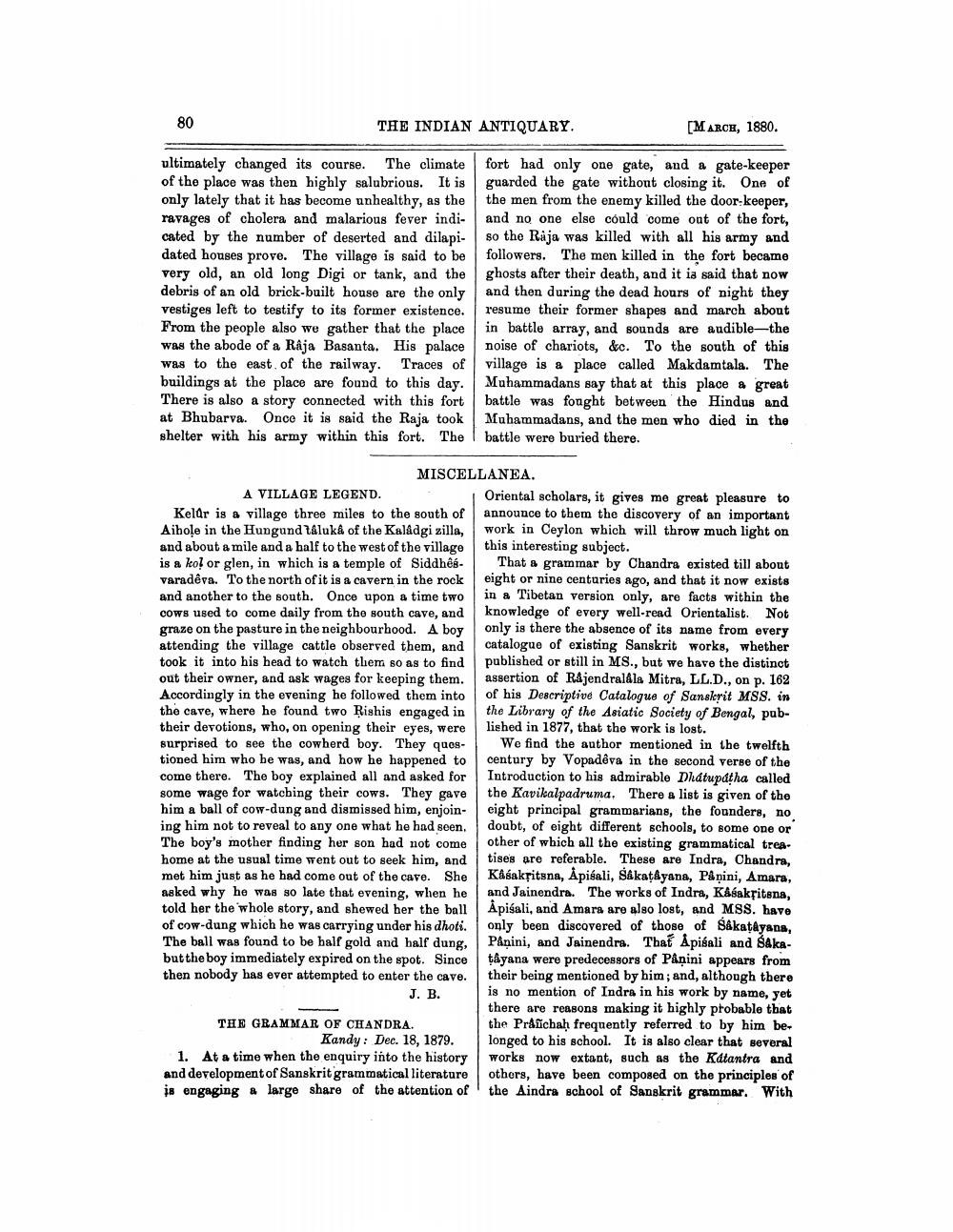________________
80
THE INDIAN ANTIQUARY.
[MARCH, 1880.
ultimately changed its course. The climate of the place was then highly salubrious. It is only lately that it has become unhealthy, as the ravages of cholera and malarious fever indicated by the number of deserted and dilapi- dated houses prove. The village is said to be very old, an old long Digi or tank, and the debris of an old brick-built house are the only vestiges left to testify to its former existence. From the people also we gather that the place was the abode of a Raja Basanta. His palace was to the east of the railway. Traces of buildings at the place are found to this day.
There is also a story connected with this fort at Bhubarva. Once it is said the Raja took shelter with his army within this fort. The
fort had only one gate, and a gate-keeper guarded the gate without closing it. One of the men from the enemy killed the door-keeper, and no one else could come out of the fort, so the Raja was killed with all his army and followers. The men killed in the fort became ghosts after their death, and it is said that now and then during the dead hours of night they resume their former shapes and march about in battle array, and sounds are audible—the noise of chariots, &c. To the south of this village is a place called Makdamtala. The Muhammadans say that at this place a great battle was fought between the Hindus and Muhammadans, and the men who died in the battle were buried there.
MISCELLANEA. A VILLAGE LEGEND.
Oriental scholars, it gives me great pleasure to Kelor is a village three miles to the south of announce to them the discovery of an important Aihole in the Hungund talukâ of the Kalådgi zilla, work in Ceylon which will throw much light on and about a mile and a half to the west of the village this interesting subject. is a ko! or glen, in which is a temple of Siddhes- That a grammar by Chandra existed till about varadêra. To the north of it is a cavern in the rock eight or nine centuries ago, and that it now exists and another to the south. Once upon a time two in a Tibetan version only, are facts within the Cows used to come daily from the south cave, and knowledge of every well-read Orientalist. Not graze on the pasture in the neighbourhood. A boy only is there the absence of its name from every attending the village cattle observed them, and catalogue of existing Sanskrit works, whether took it into his head to watch them so as to find published or still in MS., but we have the distinct out their owner, and ask wages for keeping them. assertion of Rajendralála Mitra, LL.D., on p. 162 Accordingly in the evening he followed them into of his Descriptive Catalogue of Sanskrit MSS. in the cave, where he found two Rishis engaged in the Library of the Asiatic Society of Bengal, pubtheir devotions, who, on opening their eyes, were lished in 1877, that the work is lost. surprised to see the cowherd boy. They ques. We find the author mentioned in the twelfth tioned him who he was, and how he happened to century by Vopadêva in the second verse of the come there. The boy explained all and asked for Introduction to his admirable Dhatupatha called some wage for watching their cows. They gave the Kavikalpadruma. There a list is given of the him a ball of cow-dung and dismissed him, enjoin- eight principal grammarians, the founders, no ing him not to reveal to any one what he had seen doubt, of eight different schools, to some one or The boy's mother finding her son had not come other of which all the existing grammatical treahome at the usual time went out to seek him, and tises are referable. These are Indra, Chandra, met him just as he had come out of the cave. She Kasakpitsna, Åpisali, SakatAyana, P&ņini, Amara, asked why he was so late that evening, when he and Jainendra. The works of Indra, Kåsaksitena, told her the whole story, and shewed her the ball Åpisali, and Amara are also lost, and MSS. have of cow-dung which he was carrying under his dhoti. only been discovered of those of Sakatayana, The ball was found to be ball gold and half dung, Paņini, and Jainendra. That Åpisali and SAKAbut the boy immediately expired on the spot. Since tayana were predecessors of Paņini appears from then nobody has ever attempted to enter the cave. their being mentioned by him; and, although there
J. B.
is no mention of Indra in his work by name, yet
there are reasons making it highly probable that THE GRAMMAR OF CHANDRA.
the Pratichah frequently referred to by him beKandy: Dec. 18, 1879. longed to his school. It is also clear that several 1. At a time when the enquiry into the history works now extant, such as the Kdtantra and and development of Sanskrit grammatical literature others, have been composed on the principles of is engaging a large share of the attention of the Aindra school of Sanskrit grammar. With




